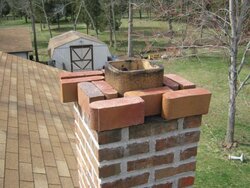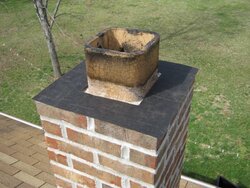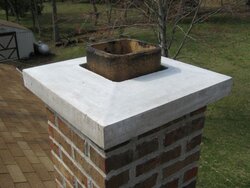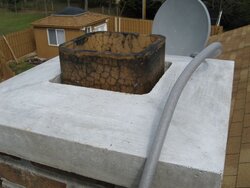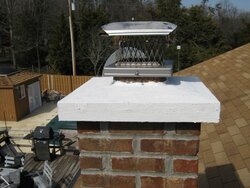The old mortar wash crown on the vent stack was replaced with a nice precast from a local company. Chiseled off the mortar wash, cleaned up the top course of brick and applied some Behr Waterproofing to the brick and the clay flue. Used some adhesive caulk to install a 30lb roofing felt bond break then let it set up overnight with some bricks for weight to allow the adhesive to bond securely to the brick.
The most difficult portion of this exercise was getting the 70 lb precast crown up to the roof.
I applied a few beads of silicone to the felt as an anchor for the crown and, with the aid of a helper, placed the crown over the clay flue.
The crown-to-flue pipe gap is approximately 1/2", which was filled with 4 layer turns of closed cell backer rod and a generous bead of silicone applied to the top of the backer rod and flush with the top of the crown.
Some ThoroSeal was brushed on the crown to fill some of the surface imperfections and give the crown additional water shedding capabilities.
A picture of the crown underside reveals a casting groove which runs on all 4 sides and acts to shed any water that makes its way over the outer crown edge and migrates back toward the brick chimney. Any water droplets that make it to the underside cannot traverse the groove and simply drop off.
The stainless cap keeps out the rodents and prevents water from entering the clay flue.
BTW - This chimney was once the vent stack for an oil fired furnace ( the reason the clay flue is blackened ), which sprung a boiler leak back in 1995. I replaced it with a high efficiency (90% +) Vailliant boiler using hot surface ignition, modified for LPG and using a motorized vent damper. Now if I can only get the Taco 571-2 zone controls working correctly.
The most difficult portion of this exercise was getting the 70 lb precast crown up to the roof.
I applied a few beads of silicone to the felt as an anchor for the crown and, with the aid of a helper, placed the crown over the clay flue.
The crown-to-flue pipe gap is approximately 1/2", which was filled with 4 layer turns of closed cell backer rod and a generous bead of silicone applied to the top of the backer rod and flush with the top of the crown.
Some ThoroSeal was brushed on the crown to fill some of the surface imperfections and give the crown additional water shedding capabilities.
A picture of the crown underside reveals a casting groove which runs on all 4 sides and acts to shed any water that makes its way over the outer crown edge and migrates back toward the brick chimney. Any water droplets that make it to the underside cannot traverse the groove and simply drop off.
The stainless cap keeps out the rodents and prevents water from entering the clay flue.
BTW - This chimney was once the vent stack for an oil fired furnace ( the reason the clay flue is blackened ), which sprung a boiler leak back in 1995. I replaced it with a high efficiency (90% +) Vailliant boiler using hot surface ignition, modified for LPG and using a motorized vent damper. Now if I can only get the Taco 571-2 zone controls working correctly.


